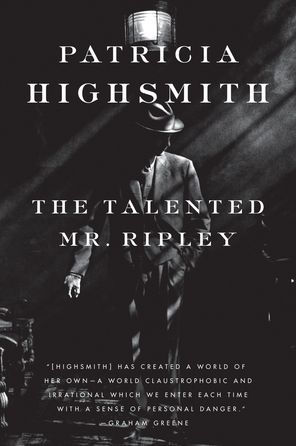Talented, Sick, and Wonderful
The late Patricia Highsmith was one of the great crime novelists of the 20th century. In her case, though, the term "crime novelist" seems unfairly limiting. She was first and foremost a novelist, and utilized stories of crime and violence to support her complex examinations of character and her acute observations of the debilitating effects of guilt, boredom, and domestic unhappiness on otherwise unremarkable lives. Born in Texas in 1921, Highsmith spent most of her life as a European expatriate, an experience that informed her fiction in a number of ways. During the course of her career, which spanned nearly 50 years, she produced 7 collections of short stories and more than 20 novels, some of which, ironically, are now better known for the film adaptations they inspired.
Her first novel, Strangers on a Train, was brilliantly filmed by Alfred Hitchcock in 1951. Her third and -- by many accounts -- best book, The Talented Mr. Ripley, has now been filmed twice. The first version, "Purple Noon," appeared in 1966. It was directed by René Clement and starred Alain Delon as the enterprising Tom Ripley. The latest version, just released in time for Oscar consideration, stars Matt Damon and Gwyneth Paltrow and has been directed by Oscar winner Anthony Mingella (The English Patient). It is one of the more anticipated movies of the season and provides a convenient pretext for a look back at the original novel and its underappreciated creator.
The Talented Mr. Ripley, which won an Edgar award as Best Novel of 1956, was the first of five books to feature the eponymous con man, Tom Ripley. As the story begins, Tom is a 23-year-old loser living a hand-to-mouth existence in New York City. A liar and inveterate role-player with vague aspirations to a better life, he drifts aimlessly from job to job and from scheme to scheme, surviving largely through the sufferance of his friends. With his latest scheme -- impersonating an agent of the Internal Revenue Service -- he has crossed the line into outright fraud and is living in expectation of imminent arrest. Just then, in keeping with his belief that "something will always turn up," an unexpected opportunity comes his way.
A wealthy shipbuilder named Herbert Greenleaf -- father of Richard "Dickie" Greenleaf, an old, casual acquaintance of Ripley's -- hires Tom to travel to Italy, track down Dickie (who is now living a bohemian life as a painter and sailor), and talk him into returning home. Tom gratefully accepts this commission, sets sail for Europe, and locates Dickie in the small Italian village of Mongibello. Dickie, who bears a surface resemblance to Tom, is living an enviable life. He owns a house, a boat, and a trust fund. Except for a platonic relationship with fellow expatriate Marge Sherwood, he is unattached and free to pursue his interest in painting, a calling for which he has more passion than talent. Tom quickly insinuates himself into Dickie's life. Eventually, driven by a compulsion he cannot resist, he claims that life for his own. On a boating trip near the village of San Remo, Tom murders Dickie, buries the body at sea, and proceeds to present himself to the world as Dickie Greenleaf.
The bulk of The Talented Mr. Ripley concerns Tom's attempts to sustain this complex impersonation, which requires him to shuttle back and forth between identities; to avoid all contact with Dickie's former friends; to maintain a believable, ongoing correspondence with the Greenleaf family; to commit forgery, larceny, even murder, in order to protect his secret. Highsmith recounts this tortuous process in a direct, unadorned style that generates considerable tension. The conclusion, which goes completely against the grain of more conventional suspense novels, brilliantly reflects the author's belief that we live in a universe in which irony rules and justice is rarely meted out.
While The Talented Mr. Ripley is an ingeniously plotted novel, its heart -- its psychological center -- lies in its carefully composed presentation of Tom Ripley. For years, critics have described Ripley as callous, calculating and, above all, "amoral," and he is surely all of those things. Mostly, though, he is a kind of visible emptiness, a void waiting to be filled with a viable -- if stolen -- identity. At one point, Marge Sherwood refers to Tom as a "nothing," and she is absolutely correct. Tom's decision to impersonate Dickie -- to become, in effect, someone else -- is a logical reflection of his essentially unformed character, which exists within a moral and spiritual vacuum. As Dickie Greenleaf -- a role he internalizes with astonishing thoroughness -- Tom acquires a sense of personal substance he has never before achieved. As Dickie, he now has a face to present to the world, and his successfully sustained performance ironically strengthens his alternate identity as Tom Ripley, a young man who finds his true self through covetousness, murder, and the systematic application of his peculiar, schizophrenic gifts.
Tom Ripley, a man immersed in a variety of roles, is among other things a great role for the right actor. It will be interesting to see just how much of his chameleon-like character Matt Damon is able to capture in the forthcoming film. Still, whatever the movie's ultimate fate might be, its appearance should focus renewed attention on Highsmith and her work, and that is entirely a good thing. If just a small fraction of the people who see the movie purchase the book, the Highsmith revival, which is long overdue, might finally come to pass. It never hurts to hope.
—Bill Sheehan


